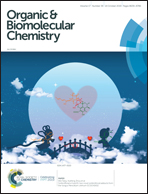Chemoenzymatic reduction of citreorosein and its implications on aloe-emodin and rugulosin C (bio)synthesis†
Abstract
A chemoenzymatic reduction of citreorosein by the NADPH-dependent polyhydroxyanthracene reductase from Cochliobolus lunatus or MdpC from Aspergillus nidulans in the presence of Na2S2O4 gave access to putative biosynthetic intermediates, (R)-3,8,9,10-tetrahydroxy-6-(hydroxymethyl)-3,4-dihydroanthracene-1(2H)-one and its oxidized form, (R)-3,4-dihydrocitreorosein. Herein, we discuss the implications of these results towards the (bio)synthesis of aloe-emodin and (+)-rugulosin C in fungi.

- This article is part of the themed collection: Chemical Biology in OBC


 Please wait while we load your content...
Please wait while we load your content...